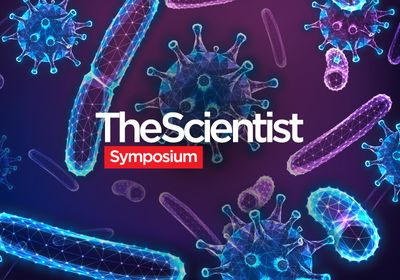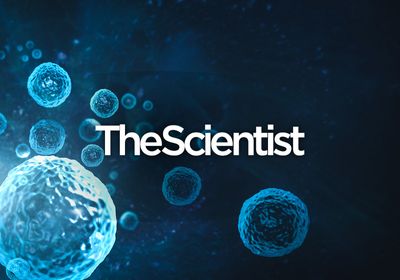ABOVE: A section of a mouse distal colon showing luminal contents with bacteria in magenta, the mucus lining in green, and the epithelial cell barrier of the gut in blue Charlotte Clayton, Tropini Lab
Dissecting wombats’ intestines isn’t the easiest way to get an idea about what’s happening with their gut microbiomes, yet that’s what University of Adelaide postdoc Raphael Eisenhofer and his colleagues did for a recent study. Collecting poop would have been easier—particularly for endangered species like wombats—but the researchers wanted more information than they could glean from a stool sample.
“We’ve been using feces for quite a long time now because they’re very easy to get, but what we know about microbial ecology is it’s all about location—where the microbes are in the interface of the host,” Eisenhofer explains.
He and his coauthors characterized the microbial biogeography, or the spatial information about what microbes are present where, of the gastrointestinal (GI) tracts of one bare-nosed wombat (Vombatus ursinus) and one southern hairy-nosed wombat (Lasiorhinus latifrons). Eisenhofer acknowledges the limitations of using just two wombats, yet the team still found some surprises.
For instance, in both animals, the distal end of the colon near the anus shared less than 20 percent of the microbial species of the proximal end near the small intestine. “I would have thought there’d be a much larger overlap there,” Eisenhofer says. And the communities found in each of the animals’ proximal colons were more similar to each other than they were to the communities in the distal colon of the same animal.
Their findings add to a growing body of work from scientists who are not only concerned about what microbes are present in the gut, but also where those microbes are and with which host cells and other microorganisms they interact. The differences identified so far in microbial communities across the gut indicate that microbial biogeography may have functional consequences. These revelations also suggest that microbiome studies based only on fecal samples may yield an incomplete picture of communities within the gut.
If researchers wanted to investigate the biodiversity of a river ecosystem, but did so by looking only at the animals at the end of the river, they’d miss everything happening upstream, explains Carolina Tropini, who studies gut microbiota at the University of British Columbia in Canada. In the microbiome field, “we’re trying to describe an incredibly complex environment just by sampling stool, and stool is really just what comes out of the river,” she says. “And in practice, all the biologically interesting stuff doesn’t happen at the end of the river.”

Going beyond stool samples
One example of the mismatch between the information gleaned from feces and what’s actually happening inside the gut comes from a study published in 2019. The authors assessed microbial community members from intestinal crypts—invaginations of the intestinal wall—in people with healthy colons and those with colorectal cancer. In addition to differences in microbes at tumor and healthy sites, the team found that about a third of the species present in healthy crypts come from the phylum Proteobacteria (since renamed Pseudomonadota), yet this phylum represents only about 1 percent of the species typically found in feces.
“One thing that people who studied river ecology always appreciated was [that] what happens upstream can often affect what’s downstream,” says Gregory Donaldson, a postdoc studying the influence of the immune system on commensal microbes at the Rockefeller University. “You may be able to measure that, but you’re not really going to understand why the river is the way it is unless you go upstream and figure out what’s going on up there.”
To uncover the information missing from stool samples, Tropini and her collaborators visualize and analyze the microbes present in the gut in as close to real time as possible. The main challenge is that it’s hard to look inside a place as well protected as the gut, she explains. Euthanizing animal models is usually necessary, while for humans, biopsies of different spots in the GI tract are needed to examine those tissues and their associated microbes. But preparing for biopsies usually includes a laxative regimen that clears out the GI tract and is likely to bias the results. According to Tropini, it’s the equivalent of a tornado roaring down the river.
While Tropini has had success developing techniques that keep the mucus layer and microbiota of GI tract samples intact for imaging without the need for laxatives, these days she’s also excited about using microfluidics to simulate the environment of the gut and capture the real time dynamics of its biogeography. These so-called “gut-on-a-chip” devices allow researchers to seed human or mouse epithelial cells onto a transparent chip, where they produce mucus, and then introduce bacteria to watch how the microbes interact with the gut cells. Donald Ingber’s group at Harvard University’s Wyss Institute has used the approach to successfully culture microbes and human intestinal cells on similar chips for multiple days.
“It’s definitely a very reduced model,” Tropini allows, “but if, for example, you’re trying to model the impact of changed flow inside the gut and how that affects bacterial attachment, you need to do it by actually looking in real time.” Taking a biopsy or dissecting the GI tract of an animal, on the other hand, only provides a single snapshot in time. Another advantage of chip-based culture strategies is that it’s possible to introduce oxygen gradients that allow both anaerobic and aerobic microbes to grow as they would in the gut, Ingber’s group has reported.
See “Organs on Chips”
Understanding relationships between neighbors
In addition to physical factors affecting resident microbes, microbes themselves influence one another. To learn more about these relationships, evolutionary biologist Corrie Moreau of Cornell University and her group assessed microbial presence in the four regions of the gut in various turtle ant species (genus Cephalotes).

Looking at the microbes present in feces, she says, “gives you a snapshot of everything that’s going on, but you can’t figure out: Do you have some sort of bacteria that bloomed in the wrong place? Do you have warfare occurring between lineages?” In ants, “we actually go in with watchmaker forceps under a microscope and carefully dissect out each and every compartment of the gut to get an image of what are the bacteria associated with it along the digestive tract.”
Moreau and her colleagues found that the midgut was dominated by only one group of bacteria, whereas the hindgut featured a more diverse community. When the researchers looked at the bacterial genomes in the two locations, they found that microbes living in isolation in the midgut had lost all the genes for warfare with other bacteria. In contrast, the bacteria in the hindgut held onto genes for producing antibiotics, which are necessary to defend their space against other microbes. The findings indicate that there is “some amount of jostling for the best position within that compartment,” Moreau explains, something that could affect the host as well.
To peer even more closely into microbial neighborhoods in the gut, Harris Wang of Columbia University Medical Center and colleagues have developed a sequencing technique inspired by methods used in ecology. “How do you study the spatial organization within a forest? It’s really hard because there are lots of trees and lots of shrubs and lots of animals, and you can’t count every single one of them,” Wang explains. So “you wall off a little plot [and use existing] analytical tools to study the differences between these plots.”
Wang’s group immobilizes GI or fecal samples in gel to lock their spatial arrangements in place, then fractures the gel into tiny plots about 30 microns in diameter and labels the DNA in each plot with a unique barcode. After sequencing, they can recreate a map of what microbes are present where, and who their neighbors are. In the mouse GI tract, they found that microbial species have different neighbors depending on where they are in the gut. And when the researchers switched mice from a low-fat to a high-fat diet, not only did microbial composition in the gut change, but the spatial organization of the microbes also shifted such that bacteria had more-diverse neighbors in mice after the diet change.
Understanding microbial neighborhoods and relationships, Harris says, is “key to what I think is the next generation of better understanding of the microbiota and how they could contribute to all the types of benefits that we’re interested in.”
Host cells are another set of microbial neighbors that researchers who work on biogeography can’t ignore. In a study published in January, for instance, the authors showed that mice with depleted immune cells had a more diverse microbiota and even distribution of microbes across regions of the gut compared to those with normal immune systems.
That push and pull between microbes and host has been Donaldson’s focus since he was a graduate student with Sarkis Mazmanian at Caltech. Donaldson, Mazmanian, and colleagues discovered that commensal microbes use immunoglobulin A (IgA), a host antibody found in mucus, to colonize the gut. In contrast, IgA makes it harder for pathogenic organisms to get a foothold in the GI tract.
The researchers also showed that, in the colons of germ-free mice, the human commensal microbe Bacteroides fragilis changes its gene expression based on whether it’s close to the host epithelium, within the gut lumen, or in the mucus. These findings and others point to the two-way relationship between host and microbes, but that bidirectionality is one thing that makes studying these interactions so challenging, Donaldson says. It’s not always clear whether the microbes direct host cell behavior, or if the host cells dictate where microbes can be and what they do.
According to Mazmanian, researchers studying the microbiome have gotten good at using DNA sequencing to profile microbial community members. “The sequencing part is pretty straightforward,” he explains. “What I don’t think we do well as a field . . . is understanding what the organisms are doing when they’re there. What products are they making? What genes are they turning on? How are they engaging cells, whether they’re epithelial cells or immune cells or neurons in the gut?”
Regardless of whether researchers are examining 30-micron microbial neighborhoods or getting an idea about the biogeography along the entire gut, one of the primary open questions, according to Moreau, is whether or not the orientation of those bacteria along the digestive tract affects host health. The next step, she explains, will be “teasing apart those fine-scale interactions,” and figuring out whether rearranging biogeography changes health outcomes.
If so, biogeography could have important implications for the use of treatments such as fecal transplants and antibiotics. When trying to introduce microbial communities to the gut, such as in treating C. difficile infection, spatial organization could be an important factor, explains Wang. If commensal microbes “normally exist in some microbial neighborhood that is very stable and robust, maybe what you really need to be moving is that entire neighborhood,” and it’s not clear whether fecal transplants accomplish this, he says. And because antibiotics kill more microbes than just the pathogens they’re intended to target, the drugs may affect the ability of neighboring strains to survive. It’s important to understand, Wang says, “the interconnectedness of these communities through space, and how different kinds of environmental changes alter that.”







